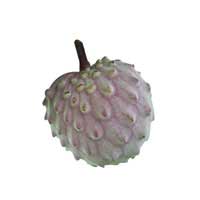 Full List of Fruits
Full List of Fruits  Ilama fruit
Ilama fruitIlama fruit
Scientific name - Annona diversifolia
Found in Central America, the Ilama fruit resembles the cherimoya and is found in different shapes like cone, heart, or ovular. With about six inches (15 cm) long, it can weigh as much as two pounds (900 g). More often it is mistaken for soncoya. They may vary from rough to fairly smooth. There are available in green and pink. The green type has a flesh that is white and sweet, while the flesh of the pink is rose color and has a tart taste.
![]() Nutritional Value of Ilama fruit
Nutritional Value of Ilama fruit
| Protein | 0.447 g |
| Fiber | 0.16 g |
| Moisture | 71.5 g |
| Calcium | 31.6 mg |
| Fat | 0.16 g |
| Ash | 1.37 g |
| Carotene | 51.7 mg |
| Iron | 0.70 mg |
| Riboflavin | 0.297 mg |
| Niacin | 2.177 mg |
| Thiamine | 0.235 mg |
| Ascorbic Acid | 13.6 mg |
![]() Health Benefits of Ilama fruit
Health Benefits of Ilama fruit
Ilama Fruit contains protein and fiber that provides high immunity power to the body and relieve from major diseases.
It is during the late June, harvesting season of Ilama begins in Mexico; however, it extends from late July to September in Guatemala and for Florida it is July to December. The fruits are waited for until its crack open, but they can be picked a little earlier and held up to 3 days to soften. In case of early harvesting, you will find the fruit to be unripe.
In general, the yield of the fruit is low. It's quite common to find no fruits during the normal fruiting period, while others will have only three to 10, very rarely some trees may bear as many as 85 to 100 fruits per season.
Consumed just like any other fruit types, the flavor of the fruit is enjoyed with a different option. The fruit is best enjoyed when you follow this- Scoop out the inner flesh of the fruit and add some small quantity of cream and sugar and serve it chill. If you would like to intensify the flavor, you can add a dash of lemon to the fruit.
There are quite a few interesting facts about this fruit type. Immune to any kind of attack from seed-boring insects, it has a hard and protective outer covering. The term 'Ilama' is also applicable to another fruit called soncoya that is more or less the same in size with a different shade i.e. grey in color.


















